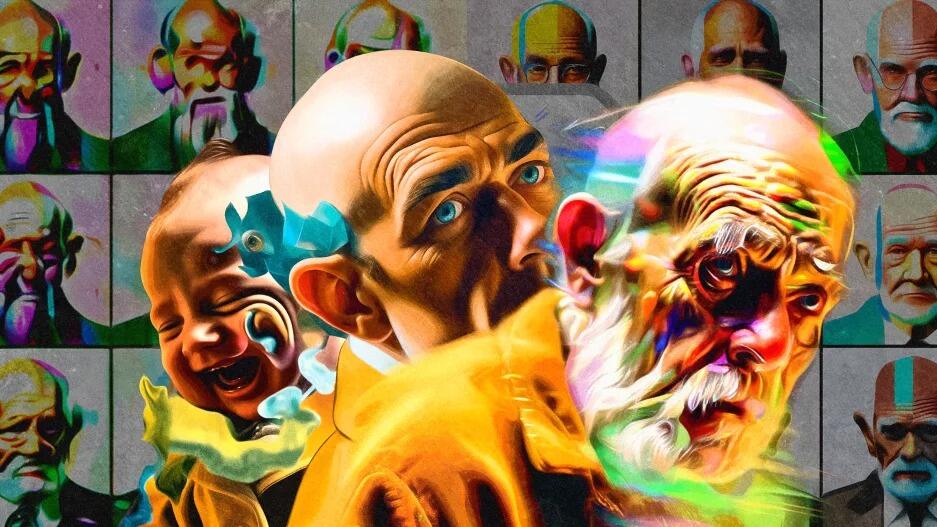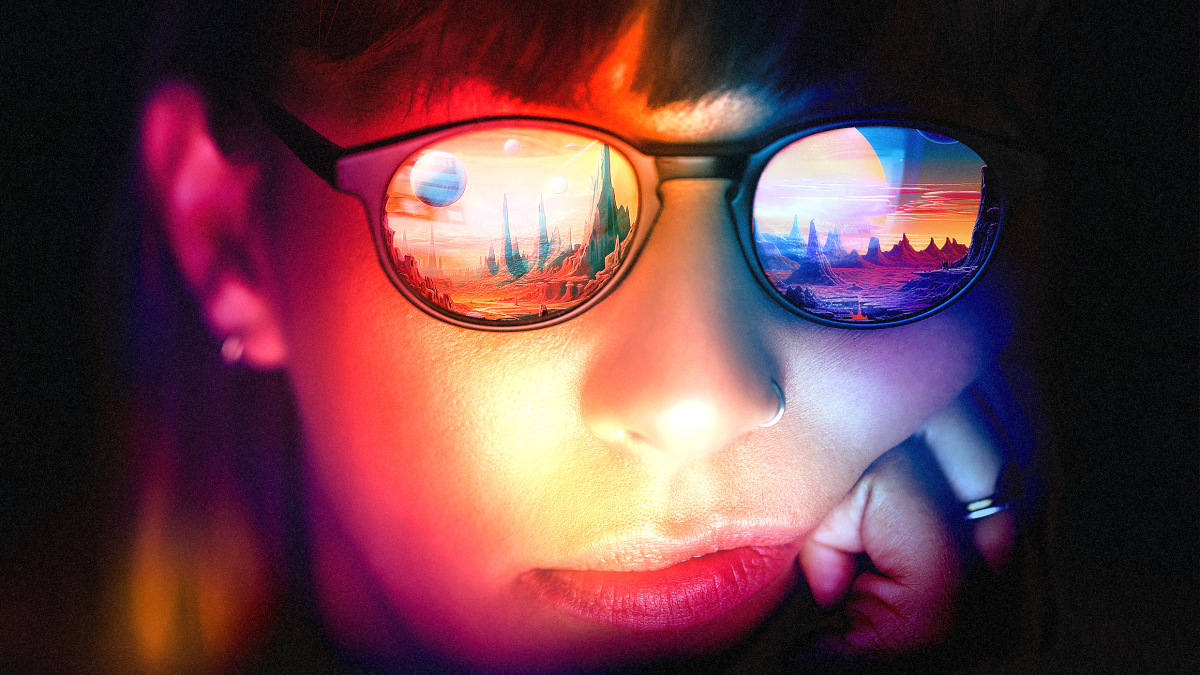- | 8:00 am
One year in, the gen AI aesthetic is already a tired trope
Images that filled us with wonder just months ago are now a sea of hyperbole.

Last December, we all got sexy. Uncomfortably, awkwardly, artificially sexy.
Every male acquaintance from high school was suddenly posting himself with Marvel-movie-approved pecks, while women blushed with an iridescent rogue, like wood nymphs with top tier plastic surgeons.
Lensa, an iOS app developed by Prisma, generated these sultry selfies through AI. Despite its dubious origins, alleged illegal collection of biometric data, and sexist tropes, society was captivated by these generated portraits. Until they very suddenly were not. Lensa AI peaked in its second month, generating 80,000 mentions (or a third of its total impressions) across social media in December 2022 before plummeting. Its mentions are down 50% in the second half of this year, according to data supplied to Fast Company by Sprout Social. (Prisma did not respond to our request for comment.)
Generative AI is the most compelling technology of our time, and yet, I, like many people, am already finding myself in a most certain AI malaise. That hardly applies to Lensa’s AI portraiture alone. The surrealist visions of architecture, products, and scenery hallucinated on demand feel equally meh. Wonder has never felt so mundane.
It doesn’t matter if it’s a happy ending for Jesse Pinkman or a house built of melted cheese. Even when the premise of AI generated art is unique—even when my eyes have never seen an idea before—my brain tosses any sense of wonder aside, sorting it into a pile of just another AI thing.
“When it comes to AI art or visuals, the aesthetic is very glossy. I feel almost like it’s conjured by someone like a magician,” says Ti Chang, an industrial designer and co-founder of the pleasure jewelry company Crave. “As humans, our eyes are drawn to the imperfection and the less flawless. So when we see these images right now…I am turned off by them, to be perfectly honest. Because I don’t feel they were generated by a human; they were prompted by a human.”
The current AI aesthetic is somehow a combination of the impossible and the rote. Images are as smooth as a Barbie doll, but like applying a beautifying filter to your face, they are paradoxically sharp and hazy at the same time; logical and senseless. The contrast is too high, and the color saturation cranked to 11. Every piece of AI art comes across like a zany flavored bag of Doritos, the first few bites are fun until you’re wondering what real food you’ll eat for dinner.
“I can tell something is AI a mile away. There’s a certain plasticity to it,” says Karla Ortiz, a Hollywood concept artist who is perhaps best known for creating the modern rendition of Dr. Strange. “But even in the more ‘realistic’ ones, it just looks like a mishmash of so many things…and it’s because it is.”
Ortiz is one of several artists who filed a class action suit against Midjourney Inc, DeviantArt Inc, and Stability A.I. that alleges their unlicensed work was used to train AI models. (The case is still ongoing.) The mishmash she’s alluding to is intrinsic to the way AI generated art works. A model may be trained on billions of images as a reference, and then it hallucinates our dreams upon command. It understands nothing of the contents of its scenes, ranging from their social norms to their physics, but it infers a lot about how things are supposed to look from examples in its dataset.
“I’ve heard [generative] AI be defined in many different ways, and I feel like the best term I’ve heard is very technical: ‘synthetic media.’ And that’s what it is. It feels synthetic,” says Ortiz. “It’s not a human communicating with another human, it makes mistakes you never see a human make. It mashes things together in a way that makes no rhyme or sense.”
Ortiz likens an AI image to a dish cooked by the top 10 chefs in the world using the top 10 ingredients. “[The chefs] mashed it all together because one dude was like, ‘I want it this way,’” she says.

The ingredients themselves have most definitely shaped the AI aesthetic. AI illustrations especially seem to feature the Procreate strokes and coloration of online fantasy imagery, as if taken straight from a J.R.R. Tolkien fan site. In fact, professional artist sites like ArtStation, or even popular semi pro sites like DeviantArt, lean toward this sort of fantasy and concept work, and their catalogs trained AI models in a multi-year smash ‘n grab.
After Stable Diffusion launched in August 2022, Prolific fantasy artist Greg Rutkowski became a shorthand for AI-based creators to generate convincing new works. AI fantasy art became something of a self-fulfilling stylistic prophecy. The system is capable of making convincing fantasy art, so people kept making more of it. Rutkowski has attempted to remove his images from AI indexing, but the dragon is already out of the bag. Fantastical imagery is now an AI mainstay. Yet whereas many of us may be over AI generation, it may have birthed its own commercially sought aesthetic.
AI AND SURREALIST TRENDS
Look no further than Canva’s 2024 trends report: Surrealism is trending—a word that means “a mix of fact and fantasy.” The service saw a 140% increase of people asking for imagery and templates that were “dreamy,” an 80% increase in “fantasy,” and a 60% increase in “ethereal.” One other popular term categorized under surrealism that caught my eye from the report was “glossy.” The exact term Chang offered to describe AI art, unprompted. When have you ever had a glossy dream, before the advent of AI?
Ortiz agrees with me that AI is likely feeding this trend, though Katrina Escalona, Art Director on the Content Creative team at Canva, is a bit more skeptical. “Surrealism is, in some ways, related to the rise of the generative AI aesthetic, but I don’t think one caused the other,” she writes. “While [gen AI] is an effective tool for surrealist-style art, I think the rise of surrealism also has a lot to do with escapism (in these crazy times) and creating something attention-grabbing and different. We also know that Gen Z values personal identity, individuality, and expressionism, which comes through in visuals that are off-kilter and nonconformist.”Whether a result of the technology or a result of the times, AI art is being both promoted and curated to prioritize the novel rather than the natural.
Ilyas Umuc is a fourth year architecture student at ODTÜ (Middle East Technical University). He is also the founder of Design Midjourney, an Instagram account he launched in August 2023 before quickly amassing nearly half a million followers, including many celebrities across the art and design world.
Design Midjourney is the crème de la crème of AI art, and Umuc is a tireless curator of the 500 pitches he receives every day (from that pile, he features only as many as three in his feed). His secret is that every image has to be unique. Each post needs to be something the public has never seen before.
“When you look at the image, of course after many times, you can realize this is AI, it’s impossible for it to be a normal design,” he says. “[But] I want people to feel they’ve seen new things, not ordinary things…In the comments, you realize, most people say, ‘I’ve never seen something like this!’ Most people are shocked.”
Umuc agrees that the current aesthetic is quite “narrow,” but he’s bullish on it evolving into a medium with more merit. In turn, he founded CapslockAI, a media company focused on covering the burgeoning AI landscape. “As you know…every person has their imagination,” says Umuc. “I think AI [models and tools] will improve more, and so we’ll see more, different things in the future.”
TIRED AI AESTHETIC, MEET NEW AI TOOLS
Victor Perez and Diego Rodriguez, who co-founded the generative AI startup Krea, are trying to build whatever AI-powered thing comes after Photoshop. And yet, despite their bullishness on this technology, the fast-paced nature of generative AI art has often reinforced the sensation of things feeling same-y, even to them.
“Every new model that appears blows my mind, but it only blows my mind the first day,” says Perez. “The first examples are amazing, but by the second day I’m already, like, not tired of it, but it’s the new floor. Now what can we do with this?”
Perez estimates that generative AI models need a 10x improvement in how they render scenes before imagery might shake off its AI aesthetic, and at the same time, people need a new wave of UX that pushes beyond the text prompt to actually give us fine tuned control over AI generation.
Meanwhile, as society, we’re finding ourselves stuck in the AI aesthetic. It’s Pong all over again.
“People went crazy over a video game like Pong even though it was two lines and a circle. Then it was like, we can do physics, so you can add acceleration. Then it was ‘so realistic!’ Then we went to Mortal Kombat’s sprites. People were saying, ‘that’s so realistic!” And you look now and it’s not,” says Rodriguez. “Toy Story one looks like trash [today]. People were saying, ‘that’s realistic!’”
Ultimately, Rodriguez argues that chapters in AI generative development will work a lot like video games. Not just in their fidelity, but in the emergence of unexpected innovation. A system like Mortal Kombat caused developers to think, not just about graphics, but of adding skeleton systems to bodies, and modeling light in space. Even Pixar had to figure out how to take a 3D figure but pop a muscle out of their bicep when a character flexed.
In each case, “they didn’t know they needed that, until that was the thing [they wanted to make],” says Rodriguez.
“That’s one of the most interesting things about this technology as a creative medium,” says Perez. “In five years or less, you’re going to use something like Krea and not care if [what you generate] is 2D, 3D, audio, video. It’s like when you’re in real life. In real life you don’t think of experiencing an image or 3D or motion. It’s everything together, that’s what AI is going to allow us to have: creative tools that more resemble reality, rather than represent what exists in reality.”
But until then? Our Marvel superhero selfies will have to suffice.





































